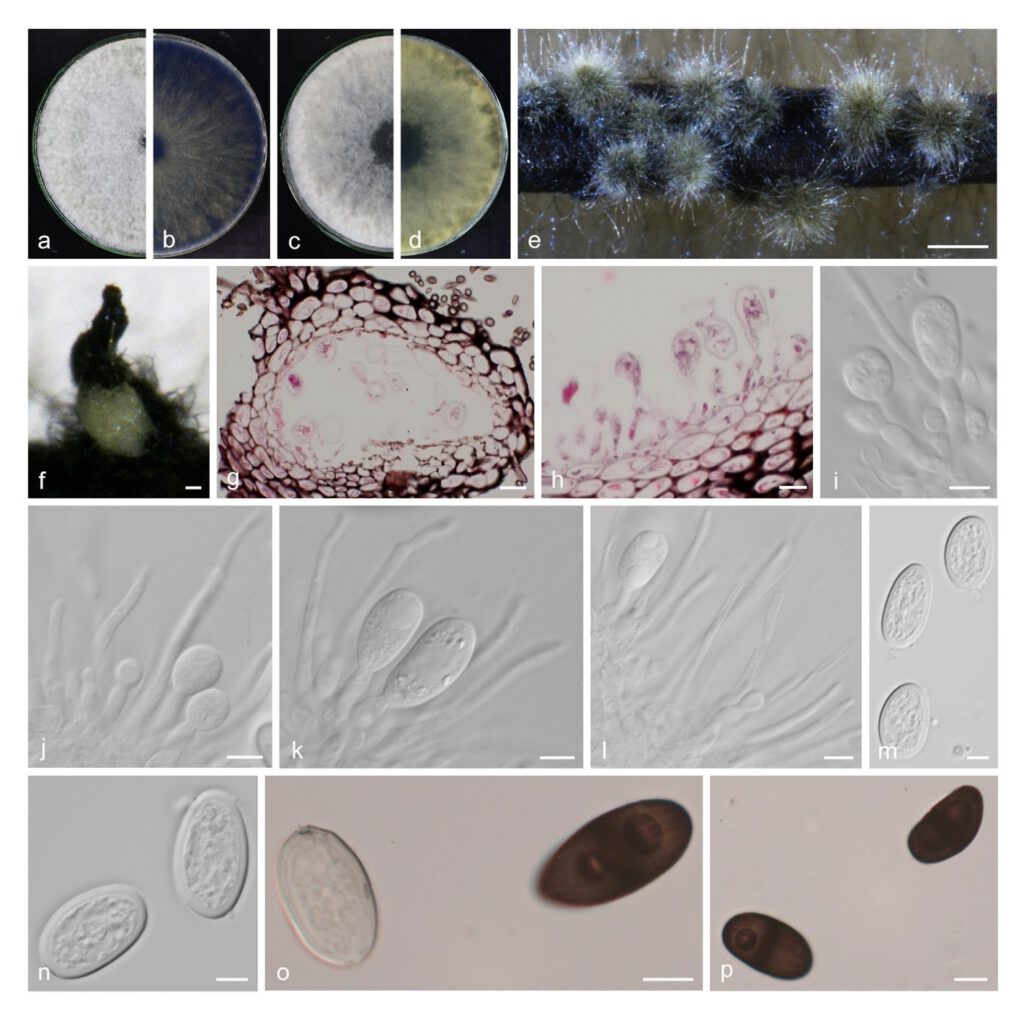Lasiodiplodia eriobotryae Yanfen Wang & M. Zhang, sp. nov. Fig. 15
MycoBank number: MB 843699; Index Fungorum number: IF 843699; Facesoffungi number: FoF 12933;
Etymology: Named after the host Eriobotrya japonica from which it was isolated for the first time.
Holotype: HMAS351943
Description
The sexual stage was not observed. Conidiomata pycnidial, produced on pine needles on WA with 2–3 wk, globose or irregular, solitary or aggregated, wrapped in hyphae embedded in needle tissue, dark brown to black, semi-immersed to superficial, up to 1286 μm high, up to 638 μm wide, yellowish translucent conidial drops exuded from the ostioles. Paraphyses cylindrical, aseptate, hyaline. Conidiophores reduced to conidiogenous cells. Conidiogenous cells cylindrical, smooth, hyaline, holoblastic forming conidia at their tips, (11–)12–14(–15) × 3– 4(–4.5) μm. Conidia hyaline, oval, rounded at the apex, smooth with granular contents, unicellular, thick-walled, wall up to 2 μm wide, becoming pigmented, 1-septate with longitudinal striations, (24.5–)25–27(–28) × (13.5–)14–16(–16.5) μm (av. = 26.3 × 14.9 μm, n = 50; L/W = 1.8).
Material examined: CHINA, Henan Province, Zhengzhou City, from branches of loquat, fruiting structures induced on needles of Pinus sp. on water agar, 15 Apr. 2021, Y.F. Wang & M. Zhang (holotype HMAS 351943, culture ex-type CDZM 081 = CGMCC 3.20841); ibid., culture CDZM 082 and CDZM 101.
Sequence data: ITS: OL863161 (ITS1/ITS4); EF1a: OM243808 (728F/986R); TUB2: OM228624 (Bt2A/Bt2B) ; RPB2:OM243836 (RPB2-LasF/ RPB 2-LasR)
Notes: Three isolates were identified as Lasiodiplodia eriobotryae in a well-supported clade. This species is most closely related to L. chiangraiensis, but easily distinguished from the size of their conidia. The conidia of L. eriobotryae (av. = 26.3 × 14.9 μm) are longer and wider than those of L. chiangraiensis (av. = 25 × 14 μm) (Wu et al. 2021). In addition, conidia of L. eriobotryae become dark brown with age and longitudinal striations, while the conidia of L. chiangraiensis are hyaline without longitudinal striations. In terms of nucleotides, on tef1 it differs four nucleotides, two in the tub2, rpb2 is not available to L. chiangraiensis.

Fig. 15 Lasiodiplodia eriobotryae. a–d. colony growing on front and back of PDA (a, b) and MEA (c, d); e–f. conidiomata on PNA; g–h. section view of conidiomata; i–l. conidiogenous cells and developing conidia between paraphyses; m–n. hyaline conidia; o–p. brown, 1-septate mature conidia. — Scale bars: e = 500 μm; f = 100 μm; g–h = 20 μm; i–p = 10 μm.
